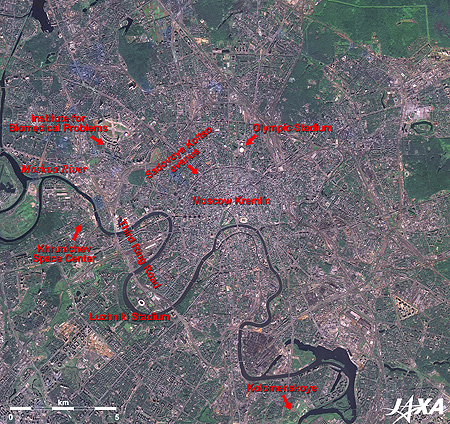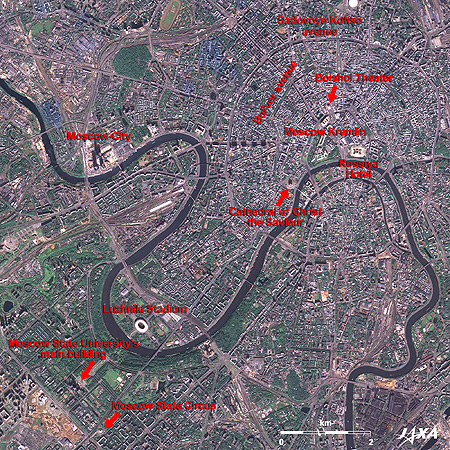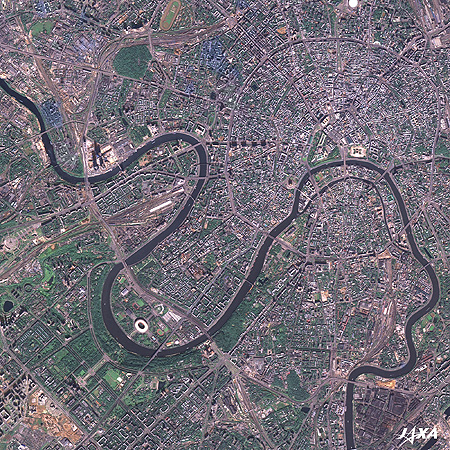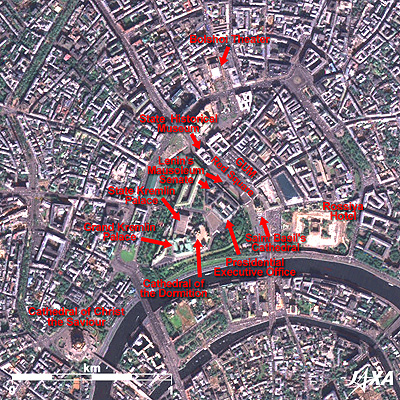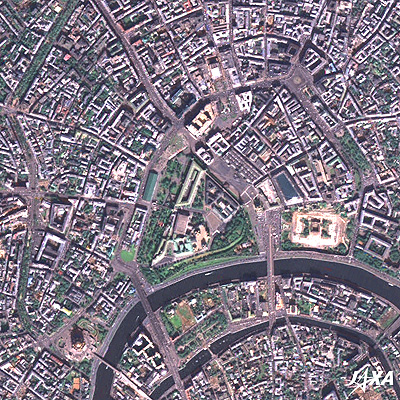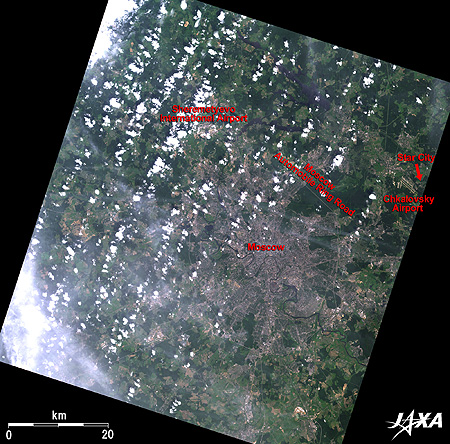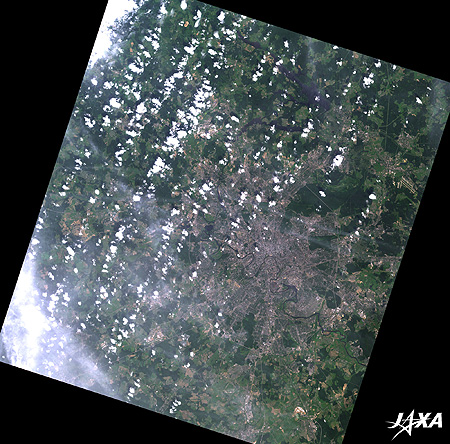Seen from Space 2009
Moscow – The City Centered on The Kremlin |
|
Fig.1 Moscow and Vicinity
Figure 1 depicts the urban area of Moscow, the capital of the Russian Federation. The dark Moskva River meanders in the lower half of the figure, flows from left to right, joins the Volga, and empties into the Caspian Sea. Every year, it freezes in November or December and begins to thaw in late March. (Fig.1 is a summer image.) Two white domes located about 3.5 km north of The Kremlin are the Olympic Stadium, the largest indoor stadium in Russia. The white elliptical building located about 5.5 km southwest of The Kremlin is the Luzhniki Stadium, which can accommodate and audience of more than 100,000. It was once called the Lenin Stadium and was the main venue of the Moscow Olympics in 1980. It is now often used for football games. The finals of the UEFA Champions League 2007-08 were held here in May 2008. It is set to be used as a main stadium of the 14th World Championships in Athletics in Moscow in 2013. On the right bank of the Moskva River at the bottom of the figure is the historic park and nature reserve called Kolomenskoye. It was the royal estate of the successive Tsars, such as Ivan the Terrible (Ivan IV of Russia) and Peter the Great. The Church of the Ascension, Kolomenskoye, built in 1532, is the oldest stone architecture now existing in Russia and was added to the World Heritage List of the United Nations Educational, Scientific, and Cultural Organization (UNESCO) in 1994. Fig.2 Urban Area of Moscow
Moscow(kmz, 1.73MB, Low Resolution) as seen on Google Earth.
A close-up view of the urban area of Moscow shows the Bul’var Avenue Ring Road with some green center dividers inside the Sadovoye Kal’so Ring Road. The urban renewal project, "Moscow International Business Center or Moscow City" is in progress on the left bank of the Moskva River, just inside the Third Ring Road, about 5 km west of The Kremlin. Some high-rise buildings are already completed and their shadows are visible there. The 612-meter-tall and 118-story super-high-rise Russia Tower under construction will be the second tallest of the world next to the Burj Dubai, but construction was suspended in November 2008 due to the economic crisis. On the opposite bank of the river, across from Luzhniki Stadium, is M.V. Lemonosov Moscow State University, which overlooks the city and is located in the green area, called Sparrow Hills. The headquarters of the famous Bolshoi Moscow Circus, which often came on tour to Japan, is also close to the university. Fig.3 Vicinity of The Kremlin and the Red Square
Figure 3 presents a close-up image of The Kremlin, the Red Square, and their vicinity. While kremlins (meaning "citadel or fortified complex") exist in many cities, the Moscow Kremlin, more than 2 km around, is the most renowned and the largest. As well as housing central governmental organizations, many buildings collected here are the essence of the Russian beauty of medieval times, such as the Grand Kremlin Palace, Uspensky Sobor Cathedral (Cathedral of the Dormition), and others. These were the Tsar’s residence in the period of the Russian Empire, and after the Russian Revolution, they were used as the Supreme Soviet, which represented the Soviet Government.
The Red Square ("Red" meaning "being beautiful" in old Russian) is located outside of the northeast wall. This is the place where images or films typically demonstrating the power and political events of the Soviet Union were disseminated to the world. Famous Saint Basil’s Cathedral, with its onion-head-shaped towers on colorful roofs, the red brick State Historical Museum, Lenin Mausoleum, and the National GUM Department Store (among others) are located around the square. It is crowded with tourists all day long. UNESCO added "Kremlin and Red Square, Moscow" to the World Heritage List in 1990. Fig.4 Full Image
Figure 4 presents the full image of Moscow and its vicinity. While, unfortunately, white clouds and thin clouds hide some of the image, the outermost Moscow Automobile Ring Road and Sheremtyevo International Airport are visible. The Moscow Automobile Ring Road is a 109 km-long asphalt-paved motor highway completed in 1961. The Sheremtyevo International Airport is the second largest airport in Russia in handling passengers and cargo. It is also the hub airport of Aeroflot Russian International Airlines.
There are also some space-related institutions in the vicinity of Moscow. Explanation of the Images: (Click the images twice to enlarge.)
(Figs. 1-4)
(Figs. 1-3) Related Sites |
